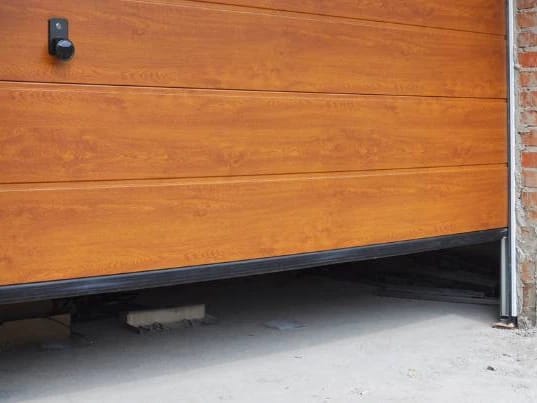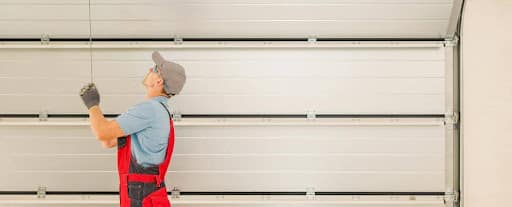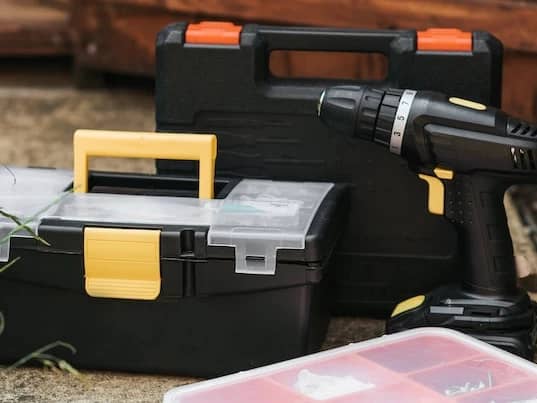Replacing garage door torsion springs can be a daunting task, but it doesn’t have to be. With the right tools and knowledge, anyone can make this seemingly difficult repair in no time.
Despite its intimidating nature, replacing garage door springs is actually quite simple – as long as you know what you’re doing!
So if you’re looking for an easy way to upgrade your garage’s aesthetic and functionality, read on and learn how to replace garage door springs the right way!
Garage Door Spring Basics
Let’s talk about the different types of springs and safety precautions when replacing them.
First, we need to understand what kind of springs are available and how to use them safely.
Types Of Springs
When it comes to replacing garage door springs, there are two types you should know about – torsion springs and extension springs.
Torsion springs provide high lifting power for heavy doors and can be adjusted with a winding bar.
Extension springs offer less lifting power but still can support lighter weight residential doors. They attach to the header above the middle of the door opening and have pulleys that assist in using leverage to lift the weight of the door.
Both styles come in different sizes so make sure you measure your existing spring before purchasing a replacement; otherwise, you could end up having an incompatible part on your hands! With this knowledge in hand, you’ll be able to tackle those garage door spring replacements like a pro.
Safety Precautions
Now that you know the basics of replacing garage door springs, it’s important to mention safety precautions.
Before attempting to replace your torsion or extension garage door spring, be sure to wear protective gear like work gloves and eye protection. This is an especially dangerous job, so don’t take any chances!
Additionally, make sure you have a partner nearby to help with lifting and maneuvering the heavy parts as well as someone who can call for emergency services if needed. It’s better to be safe than sorry when dealing with these types of repairs.
With all this in mind, you’re ready to tackle those pesky garage door springs on your own – just remember safety first!
Recognizing Worn-Out Springs

We should talk about the signs of wear that indicate a worn-out spring, and how to replace springs correctly.
We need to make sure we do it the right way, so there aren’t any issues down the road.
Signs Of Wear
Have you noticed that your garage door isn’t opening as smoothly as it used to?
If so, it could be a sign that your torsion springs are starting to wear out. These springs play an essential role in the operation of your garage door – they provide tension and power when the door is being opened or closed.
A broken garage door spring can cause serious damage if left unchecked, not only putting strain on the motor but potentially causing accidents due to sudden failure when the spring breaks.
It’s always best to replace both garage door springs at once, even if just one appears worn-out; this will ensure maximum efficiency and reliability from your system.
Replacing Springs
It’s important to act fast when you notice a problem with your garage door springs.
Replacing them is the best way to ensure that your system keeps running smoothly and safely, without putting any extra strain on the motor or risking an accident due to sudden failure.
And while replacing garage door springs may seem intimidating, it’s actually quite simple!
With some basic tools and knowledge of what type of spring system you have installed in your home, you can get the job done quickly and easily.
Plus, there are plenty of resources available online for people who need help figuring out which parts they’ll need for their particular setup.
So don’t wait – start shopping around for new torsion springs today!
Prioritizing Safety
When replacing garage door springs, your first priority should always be safety. Safely handling winding bars and broken springs is essential for anyone looking to replace their own garage door springs. The good news is that with the right tools, preparation, and knowledge, you can safely complete this task yourself!
It’s important to keep in mind that when installing new springs or removing old ones, tension will be present on the doors. This means taking extra caution when working with a winding bar and broken spring.
To ensure safe operation of your garage door system, only use factory-made parts from reputable sources. Proper installation techniques are also key – make sure you read up on all instructions before attempting any repairs or replacements.
Knowing When To Hire A Professional

Replacing your garage door springs is an important job that can be done safely and correctly if you are a skilled DIYer. But if you’re not confident in your abilities, it’s best to hire a professional to replace the garage door torsion spring.
They will have the necessary tools, know-how, and experience to get the job done right – saving you time, money, and stress. It can be tempting to try to tackle this type of project yourself but remember that replacing garage door springs requires special knowledge since they are under high tension.
Don’t risk injury or property damage by attempting this complex task on your own when professionals are available who specialize in handling such repairs. So don’t hesitate to reach out to the pros at Aaron’s Garage Door Company to fix the problem quickly and with care.
Tools And Materials Needed
Replacing a garage door spring isn’t something to take lightly. It’s not only difficult, but also dangerous if done incorrectly.
That said, the job can be made easier with the right tools and materials. When it comes to replacing your broken springs, you’ll need two types: torsion garage door springs for heavier doors or extension garage door springs for lighter ones.
You will also require some essential tools such as adjustable pliers, winding bars, and vice grips. Make sure that all of these items are in good working condition before beginning the task at hand; your safety is paramount here!
All in all, when properly equipped and prepared, replacing a garage door spring should be much less daunting than expected.
Replacing Extension Springs
Before we tackle the installation of new extension springs, let’s go over the preparations we need to make.
Once we’ve got everything in order, we can move on to installing the new springs.
Preparing For Replacement
Replacing your garage door springs can be an intimidating task, but with the right preparation and mindset you can do it! Before getting started, make sure to disconnect any power sources from the garage door opener. This includes unplugging the opener itself or turning off its circuit breaker in your home’s fuse box.
Once your safety measures are taken care of, take a moment to assess what type of spring system is used for your garage door: extension springs or torsion springs. Extension springs will require different replacement steps than torsion springs.
Make sure that you have all of the necessary tools on hand before beginning, such as a winding bar and vise grips for extension springs or a torque wrench for torsion springs. With these simple tips you’ll be well prepared to tackle replacing those pesky garage door springs!
Installing New Springs
Now that you’ve done the necessary prep work, it’s time to get installing new springs!
Installing a new extension spring requires two people and an extra set of hands. Carefully follow the instructions included with your replacement kit, then carefully thread one end of the new spring into its mount on either side of the garage door track.
Now comes the tricky part: tensioning the spring. This is where having an extra person can help – they can hold onto one side while you use a winding bar to slowly tighten up the other side until there is just enough tension for smooth operation.
With this final step complete, you should be able to enjoy your fully functional garage door as if nothing had gone wrong in the first place!
Maintenance Tips
Now that you have successfully replaced your garage door springs, it’s important to maintain them properly. One of the easiest ways to prolong the life of your springs and the overall functionality of your garage door is to apply a garage door lubricant regularly.
This will help to reduce friction between the moving parts, ensuring smoother operation and preventing premature wear and tear. Be sure to choose a lubricant specifically designed for garage doors, as these products have the right properties to handle the demanding conditions of this environment.
By taking the time to maintain your garage door springs, you can help to prevent future issues and keep your garage door operating at its best for years to come.
Replacing Torsion Springs

Measuring length & diameter is important to make sure you get the right size for your new springs. Safety precautions should be taken when replacing springs, such as wearing safety glasses and gloves.
Installing new springs can be tricky, so make sure you follow the instructions carefully.
Measuring Length & Diameter
When it comes to replacing garage door springs, measuring length and diameter is the first step.
This can be a tricky task since not all springs are exactly alike. But with the right tools and techniques you’ll soon have your torsion or extension springs replaced in no time!
Start by measuring each spring individually – from top to bottom for length, and across its width for diameter. Take note of any differences between the measurements as this will help determine which type of spring you need when buying replacements.
With these handy tips, you’re sure to get your garage door running smoothly again!
Safety Precautions
It’s important to take safety precautions when replacing garage door springs, as this can be a dangerous job. So before you start working on your torsion springs, make sure to double check that the power is off and disconnect any cables attached to them.
Wear protective gloves and eyewear too – just in case! To ensure that everything goes smoothly, it’s also best to have someone nearby who can help in case of an emergency. It’ll give you peace of mind knowing they are there for support.
Letting them know how long the process could take will also help keep everyone up-to-date with the progress. Taking these steps now will save time and stress down the road; so don’t forget to do your due diligence!
Installing New Springs
Alright, now that you know how to be safe when replacing torsion springs for your garage door, it’s time to move on to the next step – installing new springs.
You can do this yourself or hire a professional if you’d prefer; either way, make sure they follow all of the necessary safety protocols.
Once everything is in place and secure, test out the system with a few open/close cycles before declaring victory! With just a little bit of effort and care, you should have no problem getting up-and-running again with fresh, reliable garage door springs.
Frequently Asked Questions
What Is The Average Lifespan Of A Garage Door Spring?
The average lifespan of a garage door spring can vary, but typically they last between 5-10 years.
This is subject to change depending on how often you use your garage door and the environment it’s in.
If you’re noticing that your springs are starting to wear out sooner than expected or aren’t functioning properly, then it may be time for replacement. Replacing these springs isn’t as daunting as it sounds – with some patience and careful work, anyone can do this job themselves!
How Much Does It Typically Cost To Replace Garage Door Springs?
Replacing a garage door spring can be an intimidating task, but it doesn’t have to cost you an arm and a leg. It all depends on the type of springs involved and the complexity of your setup.
Generally speaking, if you’re replacing one extension spring, you’ll spend anywhere from $70-$90 while two torsion springs will run closer to $200-300.
But when done right, this investment in new springs could help extend the life of your garage door for years to come.
Are There Any Risks Associated With Replacing Garage Door Springs Yourself?
Replacing garage door springs yourself might seem like a simple task, but it can actually be quite dangerous.
Not only do you need to ensure the tension is set correctly, but you also run the risk of injury from improperly releasing the spring or having it snap back on you. It’s important to know what risks are involved and how to mitigate them before attempting this project on your own.
Is It Necessary To Have A Professional Inspect The Springs Before Replacing Them?
Replacing your own garage door springs can seem like a daunting task. But before you take the plunge, it’s important to ask: is it necessary to have a professional inspect the springs beforehand?
The answer is yes! A qualified technician will be able to identify any potential risks associated with replacing them yourself and advise on whether they need replacing at all.
This inspection could save you time, money and hassle in the long run – so don’t skip this step!
What Is The Best Lubricant To Use On Garage Door Springs?
When it comes to lubricating garage door springs, you want to make sure you’ve got the right tool for the job. It’s just like any other project: if you don’t use the correct materials, things won’t go as smoothly as they should – and that may end up costing you time and money down the line.
So when selecting a lubricant, opt for one specifically designed for heavy-duty metal components such as those found in most residential garages.
This type of lube is often referred to as a ‘high-load’ lubricant; investing in this will save countless headaches later on! With proper care and maintenance, your garage door springs can last for years.
Conclusion
Replacing garage door springs is a job best left to the professionals. Attempting this on your own can be dangerous, and if done incorrectly could cause serious injury or even property damage.
Even after replacing the springs yourself, it’s important to have them inspected by an experienced professional who can ensure that they were installed properly.
So why take the risk? Can you put a price tag on safety? A qualified technician has the necessary knowledge and experience to replace garage door springs quickly and safely – so why not hire one? With their help, you can rest assured that your new springs will last for years to come!




